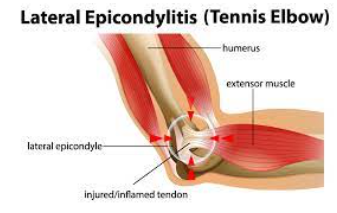by Dr. S. Sivapriya
Tennis elbow, also known as lateral epicondylitis, is a painful condition that affects the tendons on the outside of the elbow.These tendons connect the muscles in the forearm to the bony bump on the outside of the elbow joint. The pain from the tennis elbow is usually located on the outside of the elbow, just below the bony bump. It may also radiate down the forearm towards the wrist. The pain is often worse when gripping objects or twisting the wrist.

CAUSES:
Repetitive stress: This is the most common cause of tennis elbow. It can happen from any activity that involves repetitive twisting or gripping of the wrist, such as: Playing tennis or other racquet sports -Golfing -Painting -Carpentry -Plumbing -Using a computer mouse.
Improper technique: Using incorrect technique during activities like tennis or golf can put excessive strain on the tendons in your elbow.
Sudden strain: In some cases, tennis elbow can be caused by a sudden strain on the elbow, such as falling on an outstretched hand.
Age: Tennis elbow is more common in people between the ages of 30 and 50.Certain medical conditions: Conditions such as rheumatoid arthritis and diabetes can increase your risk of developing tennis elbow.
SYMPTOMS:
-Radiate down your forearm towards your wrist.
-Feel worse when gripping objects or twisting your wrist.
-Be sharp, burning, or aching.
-Occur at rest or worsen with activity. –
Weakness in your grip.
-Stiffness in your elbow.
-Tenderness to the touch on the outer side of your elbow.
DIAGNOSIS: Often, medical history and an exam are enough to diagnose tennis elbow. During the physical exam, a healthcare provider might press on the affected area or ask you to move your elbow, wrist and fingers in various ways. X-rays, sonograms or other types of imaging tests might be needed if a care provider suspects something else might be causing the symptoms.
MEDICAL MANAGEMENT:
Rest and Activity Modification: The initial step is often avoiding activities that aggravate the pain. This might involve taking a break from sports or repetitive tasks that strain the elbow tendons.
Pain Relief: Over-the-counter pain relievers like ibuprofen or acetaminophen can help manage pain and inflammation.
Ice Therapy: Applying ice packs to the affected area for 15- 20 minutes at a time, several times a day, can reduce inflammation and provide pain relief.
Bracing: Wearing a tennis elbow brace can support the muscles and tendons, reducing pain and strain during activities.
Corticosteroid Injections: Injections of corticosteroids directly into the painful area can offer temporary pain relief and reduce inflammation, but repeated injections are not recommended due to potential side effects.
Other Modalities: Ultrasound therapy, electrical stimulation, and massage therapy may be used in conjunction with other treatments to manage pain and promote healing.
Surgery: In rare cases where conservative measures fail to provide adequate relief after several months, surgery to repair the damaged tendons might be considered.
-Maintain good posture while performing activities. -Warm up before and cool down after activities that involve the elbow. -Use proper technique when participating in sports or other activities.
– Take breaks to avoid overuse. -Listen to your body and avoid activities that cause pain.
OCCUPATIONAL THERAPY INTERVENTION FOR TENNIS ELBOW:
Occupational therapists (OTs) play a crucial role in managing tennis elbow, also known as lateral epicondylitis, by addressing its impact on daily activities and preventing pain recurrence. Here’s how OT intervention can benefit you:
Pain Management Manual therapy: Techniques like massage, joint mobilizations, and myofascial release can reduce pain and muscle tension.
Splinting and taping: Customized splints or braces can immobilize the joint, reduce stress on the tendons, and promote proper positioning during activities.
Functional Improvement:
Activity modification and education: Identifying and modifying activities that aggravate the pain to prevent further injury. Learning proper body mechanics and ergonomics to optimize daily tasks.
Adaptive equipment: Utilizing tools and devices to simplify tasks and minimize strain on the elbow.
Return to work/activities: Collaborating with you and your employer to ensure a safe and smooth return to work or hobbies with appropriate adaptations.
Strengthening and Flexibility: Therapeutic exercises: Tailored exercises to strengthen the forearm muscles that support the elbow joint, improve flexibility, and regain full range of motion.
Gradual progression: Starting with gentle exercises and gradually increasing intensity and complexity as your condition improves.
Leave a Reply